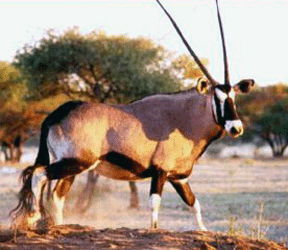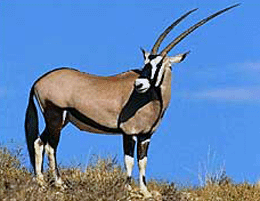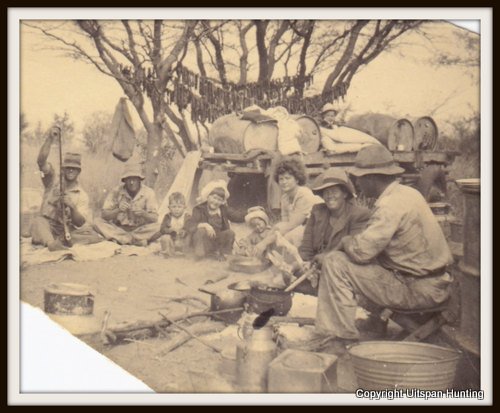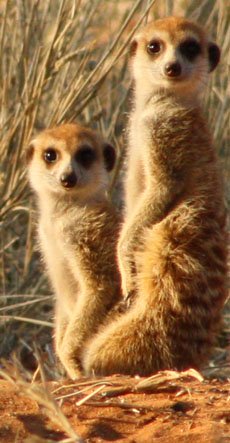For more information about our hunting safaris, don’t hesitate to reach out and contact us!
Kalahari Gemsbok Antelope
Its unique physical and physiological characteristics
Make sure not to miss
the gemsbok-video at the bottom of this page!
You will be astounded when discovering all the wonderful qualities and skills the gemsbok possesses to survive the arid and harsh environment of the Kalahari Desert of Africa.
To know these things about this splendid animal, already enhance one's admiration and respect for the nature and creation of everything part of this region.
Just look at the image of the gemsbok and you will realize that this “actor” on the Kalahari-stage, has the appearance of something dressed for a costume party... even with a mask!
Description

The animals have a shoulder height of ± 1.25m (49.2 inch) and the males weigh ± 240kg (530lb). The males and females look very much the same (both have horns) and are sometimes difficult to tell apart.
The horns of the females are usually a bit longer, thinner and sharper than those of the males.
Normally their scrotums can identify males, but when the Kalahari had a good rain season and the grass reaches their bellies, it can be quite difficult to know them apart.
The length of nice trophy horns is ± 36 inch (males) and 38 inch (females). Although the horns look like rapiers, it is seldom used for stabbing. Territorial males defend their domain by skirmishing blows to intruders. They fight by hooking with their horns backwards and sideways over the shoulders. An extremely thick skin on the neck and shoulders (to 15 mm) protect them against these blows.
Perfectly Adapted to the Kalahari
The most intriguing characteristic of the gemsbok is his ability to endure and withstand the very hot conditions of the Kalahari (and the Namib) Desert - even without any surface water for long periods of time. If water is available, they will drink more often, but they probably survive longer without it than all other game species because of their adaptability.
This antelope use different strategies to adapt to the Kalahari’s harsh environment where heat is the enemy of all living here.
Its first defense against the heat is physical orientation. Gemsbok retreat, whenever possible, to the shades of trees to avoid overheating. It will even lay down in the shades with its belly on the cooler sand. When no shade is available or when it needs to graze, the animal will take care to keep the smallest part of his body turned to the sun and the biggest part to the breeze. This is to dump excess body heat. Its white belly also helps to redirect heat and solar radiation from the red, hot sands during daytime.

Grazing is mostly done at nighttime when the moisture content of grasses and plants is higher. This way a lot of energy and fluids are saved and the animal can stay more inactive during the hottest parts of the day.
Physiological Features
Personally, I found the most fascinated quality of this antelope, its physiological remedies to counteract the extreme desert conditions.
The gemsbok (usually when it is relaxed) allows its body temperature to rise up to an incredible 45°C (113°F). This will kill other mammals. Why isn’t the gemsbok killed by it?
Let me explain how amazing this animal is created:
The most vulnerable part to such high body temperatures is the hypothalamus in the brain. The feature that protect the hypothalamus of the gemsbok (also in some other antelope, but most impressive in the gemsbok), is a feature known as the “carotid rete”. It is a maze of blood vessels that work like the radiator (cooling device) of a vehicle. Warm blood from the heart to the brain passes through this network of vessels. Veins that carry blood already cooled through evaporation (in the nasal area) surround the network. Heat is exchanged in this process and thus lowering the temperature of the blood to the brain. It is a very efficient way to protect the body and simultaneously avoid too much sweating (which has the result of fluid loss).
All the excess body temperature gained during daytime is lost at night, when temperatures in the Kalahari are always cooler.
When they are in flight or a fight (any emergencies), the gemsbok will also revert to panting as a way of cooling the body. Since it causes a loss of valuable fluids however, this is not the usual way of cooling.
Watch Gemsbok fighting
Click here to watch more selected Africa Videos!
This animal, with all the above-mentioned features, is definitely a “star” on its own unique setting and stage.
To watch it, to learn from it, to respect it and its Creator.... is a trophy to take home.
An African Trophy Hunting Safari in Namibia of Africa will enrich your life, will let you become one with nature and let you discover the basics of life again.
And an African adventure is not at all complete, without experiencing the gemsbok of the Kalahari of Namibia.
All nature’s creatures join to express nature’s purpose.
Somewhere in their mounting and mating, rutting and butting
is the very secret of nature itself.
~Graham Swift (1949)
Meaning of "Uitspan"
'Uitspan' is an Afrikaans word that means place of rest.
When the Boer settlers moved inland in Southern Africa in the 1800's, they used ox carts. When they found a spot with game, water and green grass, they arranged their ox carts into a circular laager for protection against wild animals and stopped for a rest.
They referred to such an action of relaxation for man and beast, as Uitspan.

(Picture above of our ancestors.)




